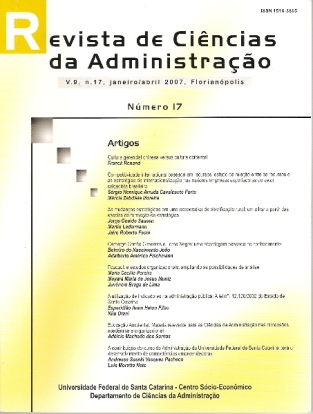As Mudanças Estratégicas em uma Cooperativa de Eletricificação Rural: um olhar a partir das escolas de formação de estratégias
DOI:
https://doi.org/10.5007/%25xResumo
Este artigo é resultado de uma pesquisa que objetiva a compreensão do processo de mudança e adaptação estratégica de uma organização do ramo cooperativista, especificamente de eletrificação rural, observando o contexto e o conteúdo do processo de mudança ao longo do histórico de vida desta organização. Nascida sob a égide do empreendedorismo teve nesta perspectiva a sua principal estratégia de crescimento. Em termos de metodologia utilizada, trata-se de um estudo de caso, com características da abordagem histórica, longitudinal e contextualista. O estudo, interpretado à luz dos pressupostos das escolas de formação de estratégias, mostra as influências de uma gestão empreendedora no crescimento da cooperativa, os impactos dos fatores políticos e conjunturais no processo de mudança da organização, como também da presença das instancias governamentais nas decisões e ações da cooperativa.Downloads
Publicado
Como Citar
Edição
Seção
Licença
O autor deve garantir:
- que haja um consenso completo de todos os coautores em aprovar a versão final do documento e sua submissão para publicação.
- que seu trabalho é original, e se o trabalho e/ou palavras de outras pessoas foram utilizados, estas foram devidamente reconhecidas.
Plágio em todas as suas formas constituem um comportamento antiético de publicação e é inaceitável. RCA reserva-se o direito de usar software ou quaisquer outros métodos de detecção de plágio.
Todas as submissões recebidas para avaliação na revista RCA passam por identificação de plágio e autoplágio. Plágios identificados em manuscritos durante o processo de avaliação acarretarão no arquivamento da submissão. No caso de identificação de plágio em um manuscrito publicado na revista, o Editor Chefe conduzirá uma investigação preliminar e, caso necessário, fará a retratação.
Os autores cedem à RCA os direitos exclusivos de primeira publicação, com o trabalho simultaneamente licenciado sob a Licença Creative Commons (CC BY) 4.0 Internacional.

Os autores têm autorização para assumir contratos adicionais separadamente, para distribuição não exclusiva da versão do trabalho publicada neste periódico (ex.: publicar em repositório institucional, em site pessoal, publicar uma tradução, ou como capítulo de livro), com reconhecimento de autoria e publicação inicial neste periódico.
Esta licença permite que qualquer usuário tenha direito de:
Compartilhar – copiar, baixar, imprimir ou redistribuir o material em qualquer suporte ou formato.
Adaptar – remixar, transformar e criar a partir do material para qualquer fim, mesmo que comercial.
De acordo com os seguintes termos:
Atribuição – Você deve dar o crédito apropriado (citar e referenciar), prover um link para a licença e indicar se mudanças foram feitas. Você deve fazê-lo em qualquer circunstância razoável, mas de maneira alguma que sugira ao licenciante apoiar você ou o seu uso.
Sem restrições adicionais – Você não pode aplicar termos jurídicos ou medidas de caráter tecnológico que restrinjam legalmente outros de fazerem algo que a licença permita.


